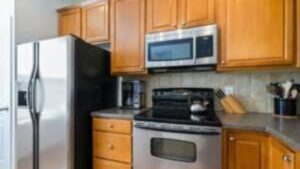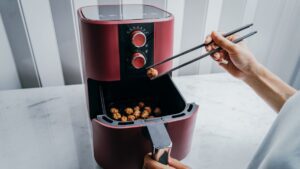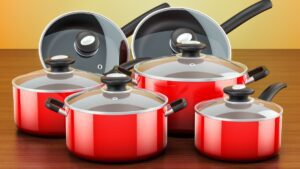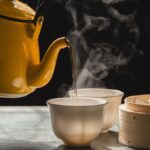The 10 Best Glass Blenders

Introduction
Best Glass blenders have gained immense popularity due to their durability, aesthetic appeal, and health-conscious features. They offer a safe and efficient way to blend ingredients for smoothies, soups, sauces, and more. In this article, we present a curated list of the 10 best glass blenders available in the market, combining performance, reliability, and customer satisfaction.

What factors should you consider when searching for a blender? Here are some glass container blender models to consider.
When searching for a glass container blender, there are several factors to consider that can help you find the best model for your needs. Here are some key aspects to focus on:
1. Glass Quality: Look for blenders with high-quality, durable glass containers. Thick, shatterproof, and heat-resistant glass is preferable, as it can withstand thermal shocks and resist scratches, stains, and odors.
2. Motor Power: Take into account the motor power of the blender. A higher wattage or horsepower indicates a more powerful blender that can handle tough ingredients and achieve smoother blending results. Look for blenders with motors in the range of 500 to 1500 watts.
3. Blade Design and Material: Check the blade design and material. Stainless steel blades are commonly preferred for their sharpness and durability. Look for blender models with robust and well-designed blades that can effectively process various ingredients.
4. Capacity and Size: Assess the capacity of the glass container. Consider your typical batch sizes and the number of servings you intend to make. Blenders come in various sizes, typically ranging from 40 to 90 ounces. Choose a capacity that suits your needs.
5. Speed Settings and Controls: Look for blenders with variable speed control or multiple speed settings. This allows you to adjust the blending speed to achieve different textures for various recipes. Additionally, pre-programmed settings can be convenient for specific tasks like crushing ice or making smoothies.
6. Safety Features: Check for safety features such as secure locking mechanisms and non-slip bases to ensure stability during operation. Safety interlocks are also important to prevent accidental starts. Some blenders may have additional features like overheating protection.
7. Ease of Use and Cleaning: Consider the user-friendliness of the blender. Look for intuitive controls, clear markings, and ergonomic designs that make operation easy. Removable blades and dishwasher-safe parts can simplify the cleaning process.
8. Noise Level: While not specific to glass container blenders, noise level can be a consideration. If noise is a concern for you, consider reading customer reviews or expert opinions to get an idea of the noise level for the models you are interested in.
When considering specific models, some glass container blender options to explore include the Vitamix E310 Explorian Blender, Blendtec Designer Series Blender, Oster Pro 1200 Blender, Ninja Professional Countertop Blender, and KitchenAid KSB1570SL 5-Speed Blender, among others. Researching customer reviews and expert opinions for these models can provide more insights into their performance, reliability, and customer satisfaction.
Ultimately, it’s important to align your blender choice with your blending needs, preferences, and budget. By considering the factors mentioned above and comparing different models, you can find a glass container blender that suits your requirements and enhances your blending experience.
The 10 Best Glass Blenders for Here.
1. Vitamix E310 Explorian Blender:
Specification
- Glass Container Capacity: 48 ounces
- Motor Power: 2.0 horsepower
- Variable Speed Control: Yes
- Blade Material: Stainless steel
Description
The Vitamix E310 is a powerhouse blender equipped with a 48-ounce glass container. It boasts a robust motor, variable speed control, and stainless-steel blades, ensuring smooth and consistent results. The glass pitcher is sturdy and resistant to scratching, making it ideal for both hot and cold recipes.
Product Pros:
- Powerful motor for efficient blending.
- Durable and scratch-resistant glass container.
- Variable speed control allows precise blending.
- High-quality stainless steel blades.
Product Cons:
- Relatively higher price point.
- A limited capacity of 48 ounces may not be sufficient for large batches.

Vitamix E310 Explorian Blender
2. Blendtec Classic 575 Blender, 90 oz Blender:
Specification
- Glass Container Capacity: 90 ounces
- Motor Power: 3.0 peak horsepower
- Pre-programmed Blending Cycles: 6
- Blade Material: Stainless steel
Description
The Blendtec Designer Series Blender features a durable glass jar with a 90-ounce capacity. It offers six pre-programmed blending cycles, a powerful motor, and a patented blade system. The touch interface and sleek design enhance its usability and aesthetic appeal.
Product Pros:
- Powerful motor for smooth blending.
- Large glass container capacity of 90 ounces.
- Pre-programmed blending cycles for convenience.
- Sleek design and user-friendly touch interface.
Product Cons:
- Higher price compared to some other models.
- Some users may find the blender bulky due to its large capacity.

Blendtec Classic 575 Blender, 90 oz Blender
3. Oster Pro 1200 Blender:
Specification
- Glass Container Capacity: 6 cups (48 ounces)
- Motor Power: 1200 watts
- Speed Settings: 7
- Pre-programmed Settings: 3
Description
The Oster Pro 1200 Blender is a budget-friendly option that doesn’t compromise performance. It comes with a 6-cup glass jar and a 24-ounce smoothie cup, making it versatile for different recipes. The blender has seven speeds and three pre-programmed settings, making it suitable for various blending needs.
Product Pros:
- Affordable price point.
- Versatile with an additional smoothie cup.
- Multiple speed settings and pre-programmed settings.
- The glass jar is easy to clean and resistant to odors.
Product Cons:
- Motor power may be lower compared to higher-end blenders.
- Some users reported durability issues with the blender’s components.

Oster Pro 1200 Blender
4. Ninja BL642 Professional Countertop Blender:
Specification
- Glass Container Capacity: 72 ounces
- Motor Power: 1100 watts
- Speed Settings: Multiple
- Total Crushing Technology: Yes
Description
With a generous 72-ounce glass pitcher, the Ninja Professional Countertop Blender is perfect for large batches. It features Total Crushing Technology for crushing ice and frozen ingredients effortlessly. The powerful motor and multiple speed settings ensure optimal blending consistency.
Product Pros:
- Generous glass container capacity of 72 ounces.
- Powerful motor with Total Crushing Technology.
- Multiple speed settings for precise control.
- Sturdy and reliable construction.
Product Cons:
- Can be noisy during operation.
- The lid may be challenging to clean thoroughly.
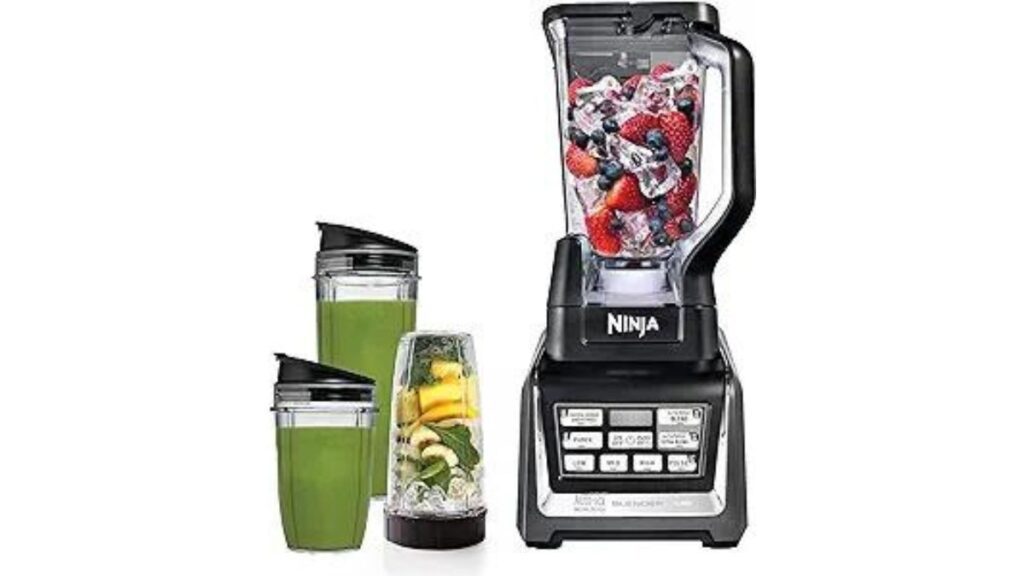
Ninja BL642 Professional Countertop Blender
5. KitchenAid KFC3516ER 3.5 Cup Food Chopper, Empire Red:
Specification
- Glass Container Capacity: 3.5 Cups
- Motor Power: 240 watts
- Speed Feature: Cord Stronge
- Intelli-Speed Motor Control: Yes
Description
The KitchenAidKFC3516ER 3.5 Cup Food Chopper offers a classic design and superior functionality. Its 3.5 Cups glass jar is both shatterproof and easy to clean. With five speed settings and Intelli-Speed Motor Control, this blender can handle a wide range of ingredients.
Product Pros:
- Classic design with a sturdy glass container.
- Multiple speed settings for various blending needs.
- Intelli-Speed Motor Control for consistent performance.
- Easy-to-use controls and ergonomic design.
Product Cons:
- The glass container capacity may be smaller compared to other models.
- The blender might struggle with tougher ingredients like frozen fruits or ice.
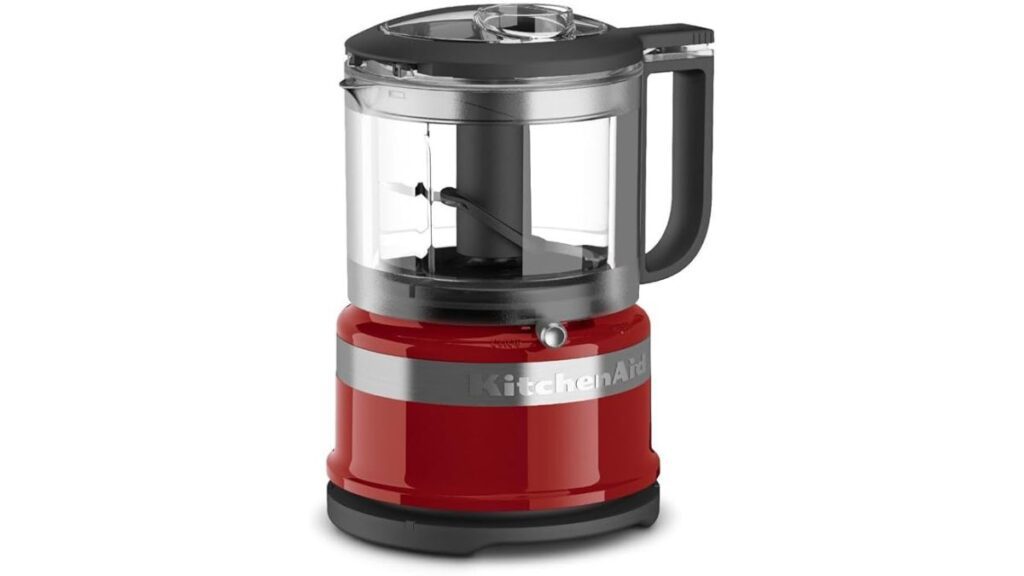
KitchenAid KFC3516ER 3.5 Cup Food Chopper
6. Hamilton Beach Wave Crusher with 40 Oz Glass Blender:
Specification
- Glass Container Capacity: 40 ounces
- Motor Power: 700 watts
- Blending Functions: 14
- Wave-Action System: Yes
Description
The Hamilton Beach Wave Crusher Blender stands out for its Wave-Action system, which pulls the ingredients down toward the blades for smoother blending. It features a 40-ounce glass jar, 14 blending functions, and a unique dispenser spout for mess-free pouring.
Product Pros:
- Wave-Action system ensures thorough blending.
- Versatile with 14 blending functions.
- The 40-ounce glass jar is suitable for moderate-sized batches.
- Dispenser spout for mess-free pouring.
Product Cons:
- The motor power may not be as high as some other models.
- The blender jar capacity may not be sufficient for larger quantities.
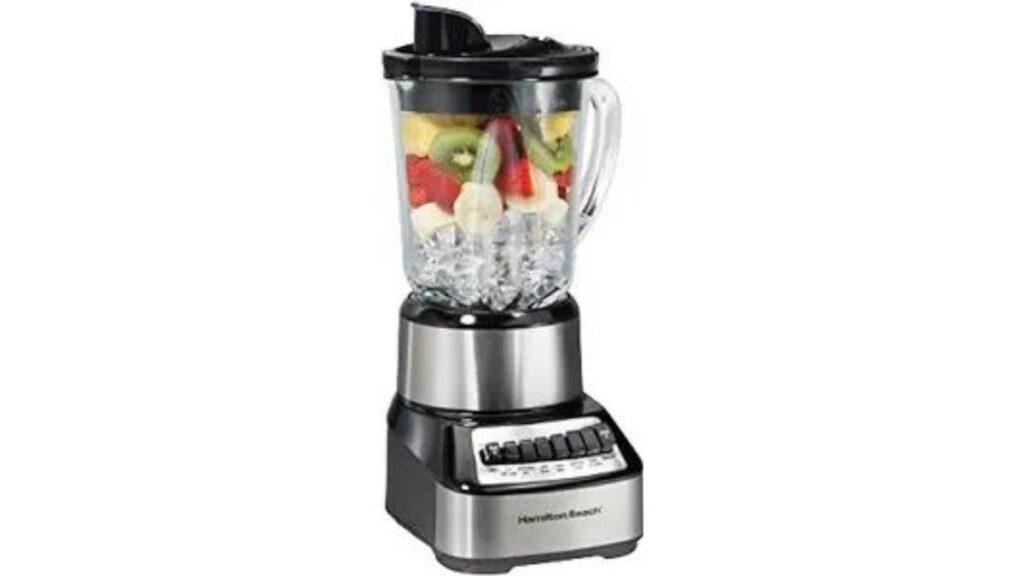
Hamilton Beach Wave Crusher with 40 Oz Glass Blender
7. Breville BBL620 Fresh & Furious Blender:
Specification
- Glass Container Capacity: Not specified (large capacity)
- Motor Power: 1100 watts
- Pre-programmed Settings: Yes
- LCD Display: Yes
Description
The Breville BBL620 Fresh & Furious Blender is a high-performance blender with a robust glass jug. Its innovative Kinetix blade system ensures efficient blending, while the LCD and pre-programmed settings make it user-friendly. The blender is also equipped with an Auto Clean function for easy maintenance.
Product Pros:
- High-performance blender with a sturdy glass jug.
- Kinetix blade system for efficient blending.
- Pre-programmed settings for convenience.
- LCD for easy monitoring.
Product Cons:
- Specific glass jar capacity is not specified.
- The blender’s price point may be higher compared to some other models.
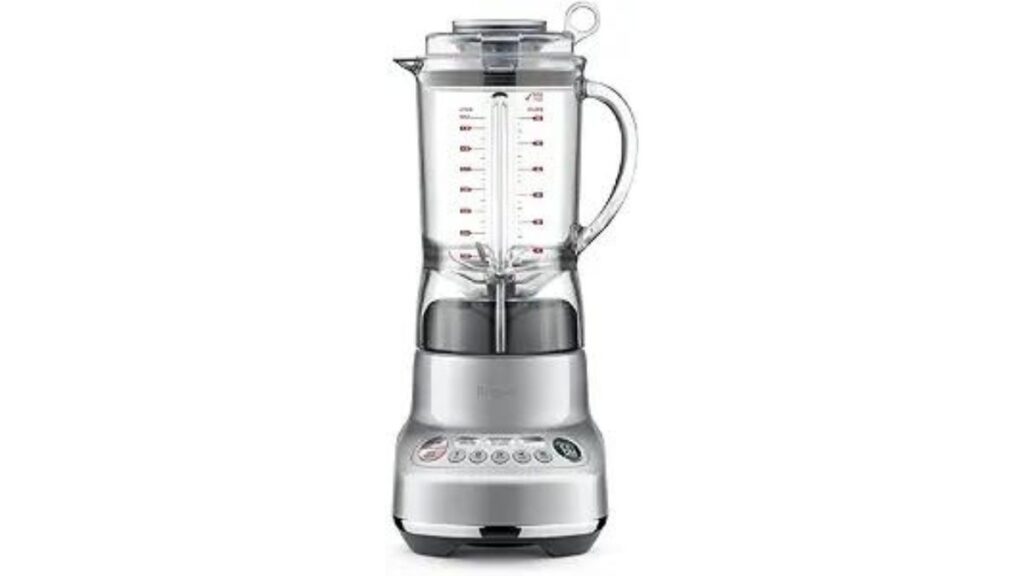
Breville BBL620 Fresh & Furious Blender
8. Cuisinart CBT-2000 Hurricane Pro Blender:
Specification
- Glass Container Capacity: 64 ounces
- Motor Power: 3.5 peak horsepower
- Variable Speed Control: Yes
- Turbo Boost Function: Yes
Description
Ideal for heavy-duty blending, the Cuisinart CBT-2000 Hurricane Pro Blender features a large 64-ounce glass jar. With a powerful 3.5-peak horsepower motor and a variable speed control dial, it can handle tough ingredients with ease. The blender also has a Turbo Boost function for extra power when needed.
Product Pros:
- Large glass jar capacity of 64 ounces.
- Powerful motor for heavy-duty blending.
- Variable speed control allows precise blending.
- Turbo Boost function for extra power.
Product Cons:
- The blender might be bulky due to the large jar size.
- Higher price point compared to some other models.

Cuisinart CBT-2000 Hurricane Pro Blender
9. SYBO Commercial Blender With Shield (SYBOCBB01):
Specification
- Motor Power: 1400 Watts
- Tamper Tool: Yes
- Blade Material: Stainless steel
Description
The SYBO Commercial Blender With Shield (SYBOCBB01). It boasts a robust 1400-watt motor and stainless-steel blades, ensuring exceptional blending performance. The 64-ounce capacity and tamper tool make it ideal for commercial and home use.
Product Pros:
- Professional-grade blender with a durable glass pitcher.
- Powerful motor and stainless-steel blades for efficient blending.
- Large capacity of 64 ounces.
- Tamper tool for processing thicker ingredients.
Product Cons:
- The blender may have a relatively higher noise level.
- Some users have expressed concerns regarding the durability of the blades.

SYBO Commercial Blender With Shield (SYBOCBB01)
10. Oster Versa Professional Power Blender, 1400 Watts:
Specification
- Glass Container Capacity: 64 ounces
- Motor Power: 1400 watts
- Dual Direction Blade Technology: Yes
- Pre-programmed Settings: Yes
Description
The Oster Versa Professional Power Blender has 1400 Watts and innovative dual-direction blade technology. This blender is designed to eliminate jams and deliver consistent results. It also has pre-programmed settings for convenience and versatility.
Product Pros:
- Dual-direction blade technology for efficient blending.
- Glass container with a 64-ounce capacity.
- Pre-programmed settings for convenience.
- Affordable price point.
Product Cons:
- Additionally, it’s worth noting that the motor power of this blender may be lower compared to certain other models.
- Some users mentioned that the blender could be prone to leaking.
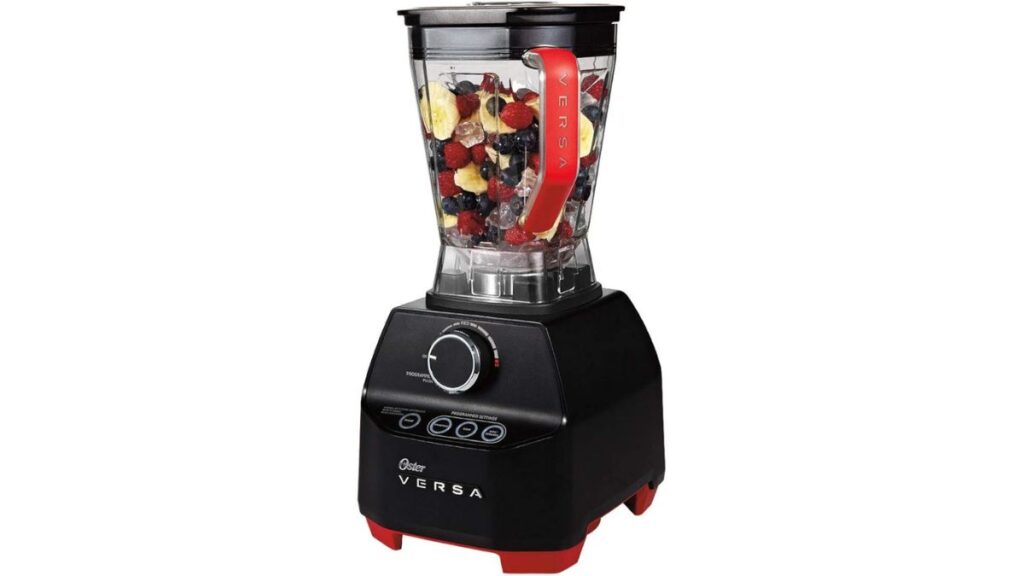
Oster Versa Professional Power Blender, 1400 Watts
Compare Plastic and Glass Blenders
Choosing between plastic blenders and glass blenders can depend on various factors. Here are some factors to consider that will assist you in making an informed decision:
1. Durability: Glass blenders are generally known for their durability, as glass is resistant to scratching, staining, and absorbing odors. It also tends to have a longer lifespan compared to plastic, which can become brittle over time. If durability is a priority, a glass blender may be a better choice.
2. Aesthetics: Glass blenders often have a sleek and premium look that can add elegance to your kitchen. If you value aesthetics and prefer a more sophisticated appearance, a glass blender might be the right option.
3. Safety: Glass is considered a safer material for food preparation compared to plastic. It is non-toxic, non-porous, and does not release harmful chemicals when exposed to heat or certain ingredients. Glass blenders are also more resistant to heat and thermal shock, making them suitable for blending hot liquids or soups.
4. Cleaning and Maintenance: Glass containers are generally easier to clean and maintain compared to plastic. They are less prone to staining and are often dishwasher-safe. Plastic containers can sometimes retain odors or become discolored over time, requiring more effort to keep them clean.
5. Weight and Portability: Plastic blenders are typically lighter than glass blenders, which can make them easier to handle and transport. If you plan to move or store your blender frequently or if you prefer a lightweight option for portability, a plastic blender might be more suitable.
6. Budget: Plastic blenders are generally more affordable than glass blenders. If budget is a concern, a plastic blender can be a cost-effective choice without compromising on functionality.
7. Noise Level: Glass blenders tend to be quieter during operation compared to some plastic blenders, which may produce more noise due to the material’s vibrations. If noise is a factor for you, consider looking for glass blenders or models specifically designed to minimize noise.
Ultimately, the choice between plastic and glass blenders depends on your personal preferences, needs, and priorities. Assess the factors mentioned above and consider what matters most to you in terms of durability, aesthetics, safety, cleaning, portability, budget, and noise level. Carefully evaluate the features and benefits of different blender models to make the best decision that aligns with your requirements.

Expert Opinion
I can share some general considerations that experts often take into account when evaluating glass blenders:
1. Durability: Glass blenders are valued for their durability and resistance to scratching, staining, and odors. Look for blenders with high-quality, thick glass containers that can withstand frequent use and thermal shock (extreme temperature changes).
2. Performance: Consider the motor power and blade design of the blender. A powerful motor ensures smooth blending and the ability to handle tough ingredients like ice and fibrous fruits and vegetables. Stainless steel blades are commonly preferred for their sharpness and durability.
3. Versatility: Assess the range of blending functions and speed settings offered by the blender. Having variable speed control and pre-programmed settings allows you to achieve different textures and consistency for various recipes.
4. Safety Features: Look for blenders that prioritize safety features such as secure locking mechanisms, non-slip bases, and safety interlocks to prevent accidental starts. Some blenders may also have overheating protection mechanisms.
5. Ease of Use and Cleaning: Consider the user-friendliness of the blender, including intuitive controls, clear markings, and ergonomic design. Additionally, blenders with removable blades and dishwasher-safe parts make cleaning more convenient.
6. Noise Level: Some blenders can be quite noisy, so it’s worth checking customer reviews or expert opinions regarding the noise level of the blender you are considering, especially if noise is a concern for you.
7. Brand Reputation and Customer Reviews: Research the reputation of the brand and read customer reviews to get insights into the reliability, performance, and customer satisfaction of the glass blenders you are interested in. Pay careful attention to both positive and negative feedback to ensure you make a well-informed decision.
Keep in mind that individual preferences and specific needs may vary, so it’s important to consider your blending requirements and priorities when selecting a glass blender. Consulting expert reviews and comparing different models can also provide valuable insights into the pros and cons of each blender.
Buying Guide
Buying Guide: Choosing the Right Blender
When in the process of shopping for a glass blender, it’s crucial to consider multiple factors to ensure you select the most suitable one for your needs. To assist you in making an informed decision, here is a comprehensive buying guide:
1. Purpose and Intended Use:
Determine the primary purpose of the blender. Will you be using it mainly for smoothies, soups, sauces, or other specific tasks?
Consider the number of ingredients you’ll be blending and whether you need a blender for personal or larger batch sizes.
2. Motor Power and Performance:
Look for a blender with a motor power that suits your blending needs. Higher horsepower or wattage generally indicates better blending performance and the ability to handle tougher ingredients.
Consider variable speed control or multiple speed settings to achieve desired blending results.
3. Container Material:
Decide between a plastic or glass container based on your preferences and requirements.
Glass containers are durable, resistant to scratching, and do not retain odors. They are also suitable for hot liquids.
Plastic containers are lightweight, less prone to breakage, and can be more affordable. However, they may be less durable and more susceptible to stains and odors.
4. Capacity and Size:
Evaluate the container capacity based on your typical batch sizes and the number of servings you intend to make.
Consider the dimensions of the blender, especially if you have limited countertop space or plan to store it in a cupboard.
5. Blade Design and Material:
Check the blade design and material for sharpness, durability, and the ability to handle different ingredients effectively.
Stainless steel blades are commonly preferred for their strength and longevity.
6. Ease of Use and Cleaning:
Look for blenders with user-friendly controls, intuitive interfaces, and clear markings.
Consider features such as removable blades, dishwasher-safe parts, and ease of disassembly for convenient cleaning.
7. Additional Features and Accessories:
Some blenders offer extra features like pre-programmed settings, pulse function, ice-crushing capabilities, or built-in timers. Assess whether these features are important for your specific needs.
Accessories such as additional blending cups or tamper tools can also be beneficial for certain recipes.
8. Brand Reputation and Warranty:
Research the reputation of the brand, read customer reviews, and consider the warranty provided by the manufacturer.
Established brands with positive customer feedback and reliable warranties can assure quality and customer support.
9. Budget:
Set a budget range that suits your requirements and prioritize features accordingly.
Determine the value you are looking for in terms of performance, durability, and additional features.
10. Safety Considerations:
Look for safety features such as secure locking mechanisms, non-slip bases, and safety interlocks to prevent accidents.
Consider models with overheating protection mechanisms for added safety.
By considering these factors and weighing your priorities, you can find a blender that aligns with your needs and enhances your blending experience. Remember to compare different models, read customer reviews, and make an informed decision based on your specific requirements and preferences.

Glass Blender 2 Juice Recipe
Here are two famous juice recipes that you can prepare using a glass blender:
1. Classic Orange Carrot Juice:
Ingredients:
- 4 large carrots, peeled and chopped
- 3 medium oranges, peeled and segmented
- 1-inch piece of ginger peeled
- Ice cubes (optional)
Instructions:
- 1. Place the chopped carrots, orange segments, and ginger into the glass blender.
- 2. Blend at high speed until the mixture is smooth and well combined.
- 3. If desired, add ice cubes and blend again to chill the juice.
- 4. Pour the classic orange carrot juice into a glass and serve it fresh for a burst of refreshing flavors.

2. Berry Blast Antioxidant Juice:
Ingredients:
- 1 cup strawberries, hulled
- 1 cup blueberries
- 1 cup raspberries
- 1 cup pomegranate seeds
- 1 tablespoon honey (optional)
- 1 cup water (adjust for desired consistency)
- Ice cubes (optional)
Instructions:
- Add the strawberries, blueberries, raspberries, pomegranate seeds, honey (if
using), and water into the glass blender.
- Blend on high speed until all the ingredients are well incorporated and the juice is smooth.
- If desired, add ice cubes and blend again to chill the juice.
- Pour the berry blast antioxidant juice into a glass, and enjoy the vibrant and tangy flavors packed with antioxidants.
Feel free to modify the recipes based on your taste preferences and the availability of ingredients. These juice recipes are not only delicious but also provide a boost of vitamins, minerals, and antioxidants. They are a great way to enjoy the natural flavors and health benefits of fresh fruits and vegetables using a glass blender.
Glass Blender Clean
Keeping your blender clean and fresh is important for maintaining its performance and preventing the buildup of residue or odors. Here are some quick steps and tips to help you keep your blender clean:
1. Immediate Rinse: After using the blender, rinse the jar and lid with warm water immediately. This helps prevent food particles from drying and becoming harder to clean later.
2. Disassemble: Take apart the blender by removing the blade assembly, gasket, and any removable parts. Follow the manufacturer’s instructions for safe disassembly.
3. Hand Wash or Dishwasher: Depending on the blender model, either wash the parts by hand using mild dish soap and warm water or place them in the dishwasher if they are dishwasher-safe. Check the manufacturer’s instructions for guidance.
4. Clean Blade Assembly: Carefully clean the blade assembly using a brush or sponge, paying attention to any food residue stuck between the blades. Be cautious as the blades can be sharp.
5. Clean the Gasket: If your blender has a gasket, remove it and wash it separately. Clean it thoroughly to remove any debris and food particles.
6. Stubborn Stains or Odors: For tough stains or odors, create a mixture of warm water and mild dish soap. Let the parts soak in the mixture for some time before scrubbing with a brush or sponge. Alternatively, you can use a mixture of water and vinegar or lemon juice for natural odor removal.
7. Dry Thoroughly: After cleaning, ensure that all the parts are completely dry before reassembling the blender. Moisture can lead to mold or bacterial growth.
8. Wipe the Base: Wipe down the base of the blender with a damp cloth or sponge to remove any spills or splatters. Avoid immersing the base in water.
9. Regular Maintenance: Consider a routine maintenance schedule, such as cleaning the blender after every use or at least once a week, depending on the frequency of use. This helps prevent buildup and keeps your blender fresh.
10. Store Properly: Store the blender with the jar and lid in a dry and well-ventilated area to prevent any moisture or odors from developing.
By following these quick steps and incorporating regular cleaning into your blender maintenance routine, you can keep your blender clean, fresh, and in optimal condition for a long time.

FAQ
Q: Can I blend hot liquids in a glass blender?
A: Yes, glass blenders are generally suitable for blending hot liquids. However, it’s important to refer to the manufacturer’s instructions to ensure that the specific glass blender model you have is designed for hot liquids. Also, be cautious when blending hot liquids as they can create steam pressure inside the blender. Start at a lower speed and blend in small batches, allowing steam to escape if necessary.
Q: Are glass blenders dishwasher-safe?
A: Many glass blender jars and some removable parts are dishwasher-safe. However, it’s essential to refer to the manufacturer’s instructions to confirm if the specific blender and its parts are dishwasher-safe. Additionally, hand washing certain components may be recommended to maintain their longevity.
Q: Can I use ice cubes in a glass blender?
A: Glass blenders are generally capable of crushing ice cubes. However, it’s important to check the blender’s specifications and instructions to ensure it is designed for ice-crushing. Some blenders may have specific settings or blades designed for this purpose. Additionally, it’s advisable to use small ice cubes or crushed ice to avoid putting excessive strain on the blender’s motor and blades.
Q: Can I blend hot soups directly in a glass blender?
A: Yes, glass blenders are suitable for blending hot soups. However, when blending hot liquids, it’s crucial to exercise caution and take necessary safety measures. Allow the hot soup to cool slightly before blending, and blend in small batches to prevent overflow. Ensure that the lid is securely in place and consider using a towel or cloth to cover the lid for added protection.
Q: How do I clean a glass blender efficiently?
A: To clean a glass blender efficiently, follow these steps:
1. Immediately rinse the blender jar and lid with warm water after use.
2. Disassemble the blender and hand wash the parts with mild dish soap and warm
water or place them in the dishwasher if they are dishwasher-safe.
3. Clean the blade assembly and gasket carefully using a brush or sponge.
4. For stubborn stains or odors, soak the parts in a mixture of warm water and mild
dish soap or a mixture of water and vinegar/lemon juice.
5. Dry all the parts thoroughly before reassembling the blender.
6. Wipe down the base of the blender with a damp cloth or sponge.
7. Regularly maintain the blender by cleaning it after each use or at least once a
week, depending on usage frequency.
Q: How can I reduce the noise level of my glass blender?
A: Noise levels can vary between blender models. To help reduce the noise level of your glass blender, you can place a kitchen towel or silicone mat underneath it to absorb vibrations. Additionally, ensure that the blender jar is properly secured on the base, as loose fittings can contribute to noise. Some blenders also have noise reduction features or technologies, so consider looking for models specifically designed to minimize noise if it is a concern for you.

Conclusion
When it comes to the best glass blenders, these ten options stand out for their performance, durability, and user satisfaction. Whether you’re looking for a powerful high-end blender or a budget-friendly option, there’s a glass blender on this list to suit your needs. Consider your blending requirements, budget, and desired features to choose the perfect glass blender that will simplify your culinary adventures.
You can see the Best Blenders Under $100 product. Maybe you like it. Details Review Here

